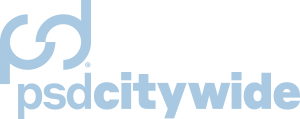When it comes to processing service requests, tracking permit applications, and developing meaningful reports, not all digital solutions are created equally.
Comparing Digital Citizen Platforms: What Makes the Citizen Portal Unique
As municipalities seek to meet their citizen’s digital needs, various software solutions have been employed, tested, and developed. One thing is clear: not all digital solutions are created equally. However, it is undeniable that community members desire straightforward, accessible and communicative tools when submitting maintenance service requests, suggestions, permit applications, and more.
To help municipalities navigate the decision-making process, this article guides you through the types and differences between digital citizen platforms currently available, and the standards you should expect when acquiring new public-facing software.
Different Levels of Service in Digital Solutions
With an overwhelming number of options available for local governments to adopt in their quest to meet their communities’ needs, it is important to consider the different levels of service (LoS) that each software provides. Governments looking to effectively manage service requests, permit applications, and citizen questions need a streamlined process to coordinate the many moving parts.
Traditional online service portals created through inline frames (iframes) require manual processing, workflow coordination, and provide limited transparency. The PSD Citywide Customer Portal is an integrated system that directly connects with existing municipal workflows within the Citywide Platform, and opens communication channels. When it comes to levels of customisation, transparency, integration, visualisation, and specificity, traditional inline forms and the Citywide Customer Portal provide significantly different levels of services.
Customisation
Traditional online service request forms (iframes)
With traditional embedded forms for service requests, the fields of the form can be customised to suit the needs of the municipality. Each form would typically connect to a siloed answer collection system, and require independent monitoring and delegation to ensure that each request is attended to.
When it comes to permitting, inline frames cannot combine permitting applications and service requests into one platform. Instead, a separate ePermitting application is necessary for digital permit applications. Both the service request forms and ePermitting software require manual updates as needed.
The Citywide Customer Portal
The Citywide Customer Portal can be entirely customised to meet the needs of the municipality and increase the ease of use for citizens. Within one portal, municipalities can create and offer a multitude of request templates for different types of services without requiring or monitoring separate forms. For instance, municipalities can create a template for a tree removal request that citizens can choose to use and have certain fields automatically completed without navigating between separate web pages or forms.
Further, the Citywide Permitting application can seamlessly integrate into the Citywide Customer Portal. Community members need not leave the portal to submit permit applications. Like service requests, municipalities can create unlimited permit application templates to reduce the risk of incomplete applications, simplify the process for citizens, and meet their specific needs. Each aspect of the Citywide Customer Portal can be modified to adapt to the municipality’s goals and citizen’s expectations within one, integrated application.
Transparency
Traditional online service request forms (iframes)
Transparency is essential for governments to build trust with their constituents. Traditional online inline frames provide limited transparency between municipalities and citizens. Often, forms will provide confirmation to citizens that their request has been received, but there is no way for citizens to access updates on the status or progress of their submission. To communicate updates, municipal administrators must manually send email updates. Frequently, citizens never hear back about the status of their request if they don’t initiate further communication.
The Citywide Customer Portal
One of the Citywide Customer Portal’s greatest strengths is the continuous channel of communication it provides between municipalities and their citizens. For example, when community members submit requests for public works, they are automatically integrated into the existing workflow through the Citywide Maintenance system. Citizens are then able to track the progress of their requests through the Citizen Portal as the public works team is dispatched, and then fixes or repairs the issue. Like tracking a package delivery online, the Citizen Portal updates when the request is added to a work order, in the process of completion, and when it has been addressed. Furthermore, municipal administrators can communicate with citizens through the Portal if they require more information.
Integration
Traditional online service request forms (iframes)
Traditional online service request forms can be integrated into municipal websites and citizens can easily submit requests online through the embedded digital forms. Inline frames do not require citizens to navigate through separate web pages or applications outside of the municipal website.
On the back end, however, the form responses are not easily integrated into municipal workflows or related software. The responses are emailed to an administrative coordinator who must pass them along to the person responsible for the request’s content. The administrators must manually coordinate and process each request to ensure that it is completed and monitored effectively. While inline frames are well integrated on the citizen-facing website, they require significant coordination for municipalities.
The Citywide Customer Portal
The Citywide Customer Portal, on the other hand, creates a seamless connection between citizens and municipal workflows, data collection, and reporting. When a citizen submits a request it is immediately entered into either Citywide Maintenance or Citywide Permitting, depending on the configuration and applications activated by the municipality. If it is a maintenance request, it is assigned a priority level, GIS location, specific asset, and employee to take ownership of the request. The crew member responsible for the specific type of request is automatically notified and can easily choose to add it to an existing work order, generate a new work order, or mark it as complete.
There are many instances where municipalities will offer fillable forms to their residents in PDF format. Permitting, Licensing, and Planning requests are a prime example, where citizens must download or print the forms before filling them out, which often requires additional steps of scanning, saving, and finally manually emailing them back out to the right person. The Citywide Customer Portal, when combined with the Citywide Permitting module, eliminates this tedious process by integrating each component of a permit form into one platform that connects to municipal workflows.
Permit applications submitted through the Citywide Customer Portal are directed to those responsible on the back end with all of the required details for reviewing the application. Each update and comment necessary for the permit application can easily be communicated through the Portal to the applicant. Permit information and data are integrated into the reporting system for municipal decision-making and evidence-based budgeting.
Visualisation
Traditional online service request forms (iframes)
Siloed forms and manual coordination processes make it difficult to aggregate visual data from many service request submissions, and identify trends over long periods of time and compare different types of services. With traditional inline forms, requests are simply submitted as emails, which would require a separate tool for staff to enter the information to gain insights from the requests submitted within a given period.
The Citywide Customer Portal
With the Citywide Customer Portal, data analysis is much easier. Whether the Citywide Customer Portal is configured with Citywide Maintenance, Citywide Permitting, or both – data is sent seamlessly into the Citywide Platform. Reports can be run from each application to show trending issues. Further, with the addition of Citywide GIS or the use of GIS Viewer to bring in data from other GIS systems, governments can see exactly where maintenance is required, how often, and the risk level. Custom filters, legends, and colour coding provide a seamless opportunity for the user to present new information and effectively monitor the community’s needs.
Specificity
Traditional online service request forms (iframes)
Online service request forms are limited to the level of detail allowed in the forms’ fields. They frequently have long-form answer submissions where citizens can submit detailed notes regarding their submissions. If maintenance related, these submissions are not guaranteed to be connected to work orders created from the service requests. Municipalities must manually add attributes, characteristics, risk levels, and priority status after the form is submitted. Similarly, for permitting, planning, or licensing applications, iframes are limited in how much information they can collect and in validating the application’s overall completeness and integrity.
The Citywide Customer Portal
Alternatively, citizens can use the Citywide Customer Portal to provide detailed notes, add relevant attachments, and provide highly specified requests or comments. On the back end, municipalities can add various attributes, characteristics, and updates to the service requests and permits that citizens submit. The level of detail through the Citywide Customer Portal ensures that communication is as holistic and accurate as possible.
Final Takeaways
Although inline forms and the Citywide Customer Portal both allow citizens to submit their concerns and service requests digitally, they do not offer the same degrees of efficiency or flexibility. With fixed features, fragmented communication channels, restrictions on data reporting, and limited integration, traditional inline forms provide a highly manual experience for municipalities. The Citizen Portal is entirely customizable, transparent, and fully integrated with the Citywide Maintenance and Citywide Permitting modules.
Communities are growing at unprecedented rates, with demands for infrastructure and maintenance rapidly increasing. That’s why the Citywide Customer Portal was designed to be a streamlined, effective, and efficient platform to digitally connect municipalities to their community. Through the Citizen Portal, municipalities can ensure that citizen demands for digital access and high-quality maintenance are met.
Curious to learn about the benefits of PSD Citywide’s Customer Portal as it relates to community maintenance or permitting? Our consultants are ready to help.



